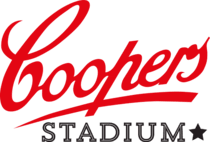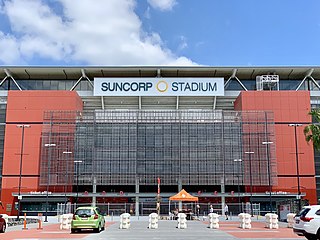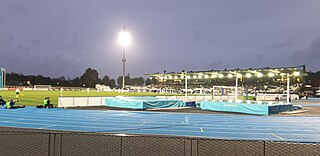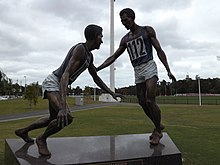
The Melbourne Cricket Ground (MCG), also known locally as The 'G, is an Australian sports stadium located in Yarra Park, Melbourne, Victoria. Founded and managed by the Melbourne Cricket Club, with 95,000 seats and an additional 5,000 capacity in standing room for a total of just over 100,000 it is the largest stadium in the Southern Hemisphere, the 11th largest globally, and the second-largest cricket ground by capacity, after the Narendra Modi Stadium. The MCG is within walking distance of the city centre and is served by Richmond and Jolimont railway stations, as well as the route 70, route 75, and route 48 trams. It is adjacent to Melbourne Park and is part of the Melbourne Sports and Entertainment Precinct.

Stadium Australia is a multi-purpose stadium located in the Olympic Park section of Sydney, New South Wales, Australia. The stadium, which in Australia is sometimes referred to as Sydney Olympic Stadium, Homebush Stadium or simply the Olympic Stadium, was completed in March 1999 at a cost of A$690 million to host the 2000 Summer Olympics. The Stadium was leased by a private company, the Stadium Australia Group, until the Stadium was sold back to the NSW Government on 1 June 2016 after NSW Premier Michael Baird announced the Stadium was to be redeveloped as a world-class rectangular stadium. The Stadium is owned by Venues NSW on behalf of the NSW Government.

Canberra Stadium is a facility primarily used for rugby league and rugby union games, located adjacent to the Australian Institute of Sport in Canberra, the capital of Australia. It is the largest sports venue by capacity in Canberra.

The Sydney Football Stadium, commercially known as Allianz Stadium and previously Aussie Stadium, was a football stadium in the Moore Park suburb of Sydney, New South Wales, Australia. Built in 1988 next to the Sydney Cricket Ground, the stadium was Sydney's premier rectangular field venue for rugby league, rugby union and football.

Docklands Stadium, known by naming rights sponsorship as Marvel Stadium, is a multi-purpose sports and entertainment stadium in the suburb of Docklands in Melbourne, Victoria, Australia. Construction started in October 1997 and was completed in 2000 at a cost of A$460 million. The stadium features a retractable roof and the ground level seating can be converted from oval to rectangular configuration.

Lang Park, nicknamed "The Cauldron", also known as Brisbane Stadium and by the sponsored name Suncorp Stadium, is a multi-purpose stadium in Brisbane, Queensland, Australia, located in the suburb of Milton. The current facility comprises a three-tiered rectangular sporting stadium with a capacity of 52,500 people. The traditional home of rugby league in Brisbane, the modern stadium is also now used for rugby union and soccer and has a rectangular playing field of 136 by 82 metres. The stadium's major tenants are the Brisbane Broncos, the Dolphins (NRL), the Queensland Reds and the Queensland Maroons.

The Melbourne Sports and Entertainment Precinct is a series of sports stadiums and venues, located in Melbourne, Victoria, in Australia. The precinct is situated around 3 km east of the Melbourne central business district, located in suburbs of Melbourne and Jolimont, near East Melbourne and Richmond.

South Melbourne Football Club is an Australian semi-professional soccer club based in suburb of Albert Park, in Melbourne, Victoria. The club currently competes in the National Premier Leagues Victoria, with matches played at Lakeside Stadium.

Perth Rectangular Stadium is a sports stadium in Perth, the capital of the Australian state of Western Australia. Located close to Perth's central business district, the stadium currently has a maximum capacity of 20,500 people for sporting events and 25,000 people for concerts, with the ground's record attendance of 32,000 people set during an Ed Sheeran concert in 2015. The land on which the stadium was built, known as Loton Park, was made a public reserve in 1904, with the main ground developed several years later.

Hindmarsh Stadium is a multi-purpose stadium in Hindmarsh, an inner western suburb of Adelaide, South Australia. It is the home of the Australian A-League team, Adelaide United.

Sport is a significant aspect of the Brisbane lifestyle. Activities range from the occasional international event, annual competitions, competitive leagues and individual recreational pursuits.
Princes Park is an Australian rules football ground located inside the Princes Park precinct in the inner Melbourne suburb of Carlton North. Officially the Carlton Recreation Ground, it is a historic venue, having been Carlton Football Club's VFL/AFL home ground from 1897.

Viking Park is an 7,000 capacity multi-sport stadium located in the Tuggeranong Valley suburb Wanniassa, Canberra, Australia. It has a rectangular playing surface which is used primarily to host rugby union matches but additionally has hosted rugby league, Association football and baseball. It is home to the Tuggeranong Vikings and all matches of the ACTRU Premier Division finals, the Canberra Vikings who compete in the National Rugby Championship and the Tuggeranong Vikings Baseball Club. Viking Park is also regularly utilised by ACT-based Super Rugby club The Brumbies, who use the venue for training and who used to play home matches in the Australian Provincial Championship there.

Perry Park is a 5,000-capacity sporting ground located in the Brisbane suburb of Bowen Hills. Perry Park is home to the Brisbane Strikers, which plays in the National Premier Leagues Queensland.

The Melbourne Rectangular Stadium, referred to as AAMI Park due to a sponsorship arrangement, is an outdoor sports stadium situated on the grounds of Edwin Flack Field within the Sports and Entertainment Precinct in the heart of the Melbourne central business district.

Middle Park was a soccer venue located in Middle Park, Victoria, Australia. Built in 1959, it was used by South Melbourne FC as a home ground from their inception in 1959, as well as by Melbourne Hakoah until their demise in the 1980s. The ground was demolished in 1994 as part of works for the Melbourne Grand Prix Circuit. The ground held approximately 18,000 people, and consisted of a main stand with a capacity of 2,000, with open terracing around the rest of the ground.

Rugby league football has been played and watched by people in the Australian state of Victoria since the early 20th century. While for most of its history there the game's popularity has been marginal due to the dominance of Australian rules football in Victoria, rugby league's popularity has rapidly increased in recent years in the state's capital of Melbourne, due mainly to the introduction of a professional Melbourne-based team in the national competition.

Sunshine Coast Stadium is a multi-sport venue located at Bokarina in the Kawana Waters urban centre on the Sunshine Coast, Queensland, Australia. The stadium is the main venue in a sporting precinct that also includes seven fields.

Lakeside Stadium is an Australian sports arena in the South Melbourne suburb of Albert Park. Comprising an athletics track and soccer stadium, it currently serves as the home ground and administrative base for association football club South Melbourne FC, Athletics Victoria, Athletics Australia, Victorian Institute of Sport and Australian Little Athletics.






















